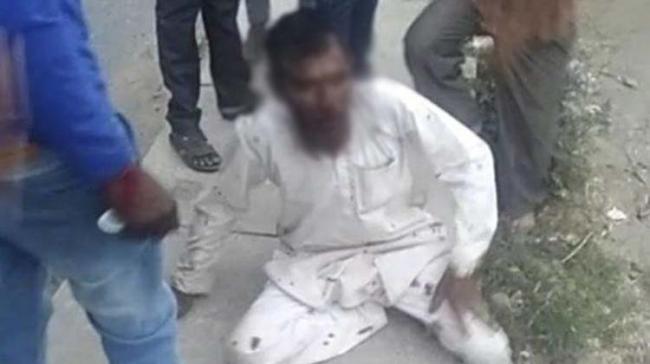Lynchings In The Time Of Voyeurism, Social Media Misuse

Radhika Sharma
New Delhi: Social media platforms are the medium and vigilantism the message.
Delivered by volatile crowds provoked to murderous rage, the all-too frequent lynchings are being played in all their goriness within hours on smartphone screens across India.
Affordable smartphones and the rapid spread of mobile internet have come together in recent months to lay bare the brutality of lynchings in chilling detail – savage mobs kicking and pummelling mercilessly, helpless victims cowering and begging for their lives and then, their bloodied and broken bodies lying limp in the dirt.
As lynching becomes the new buzzword, occupying headline space and dominating drawing room discussions, the montages of violence circulated endlessly highlight the gratuitous nature of the killings, the brittle civility that gives way only too easily to collective violence and the nonchalance of the bystander busy capturing the action rather than saving the victim.
It's a lethal cocktail of voyeurism, the fear of missing out, or FOMO as it has come to be known, desensitisation and maybe just plain apathy underscored by the need for validation, said experts as the numbers spiral and they attempt to get a grip of why a mob behaves the way it does.
In 2015, when 52-year-old Mohammed Akhlaq was beaten to death in Bisada village in Dadri on the outskirts of Delhi on suspicion that he had stored beef in his home, it sent shockwaves through the country.
Three years later, the cases continue to pile up, with the latest being the lynching of suspected cow smuggler Rakbar Khan in Alwar, Rajasthan, but the outrage has dulled.
Fuelled by rumours that they are cattle smugglers or child abductors, the cases are reported from across the country. At least 25 people are believed to have been lynched this year.
Attempting to explain the hows and whys of mob psyche, Dr Cicilia Chettiar, head of department, Department of Psychology at Mumbai's Maniben Nanavati Women's College, said the country is a "mix of collectivist and individualistic mini cultures".
In her view, lynchings are not going to be curbed anytime soon as society is power hungry and "uninvolved".
"We are an uninvolved society. We are also a culture which wants to show that I'm bigger than you, I've got something more powerful than you. That powerful or important thing could be a positive thing or a negative.
"As long as it's powerful - that I got this first - perhaps the video of someone dying or in an accident… elicits the feeling of self-assertion," Chettiar told PTI.
Sometimes, she added, people thrashing a person to death have no connect with the incident.
"Often, they are taking out their frustration. I can't do it with my boss or home or the system. We as humans don't like talking badly about ourselves. We tell ourselves a story about our own life. We don't want to introspect as we cannot manage this cognitive overload." According to experts, easy access to social media platforms has amplified the voyeuristic tendency in people and the need to be the first to carry and disseminate the ‘news'.
Instead of intervening and preventing the situation from getting bad to worse, people either tend to stand around as mute spectators or jump into the crowd to participate in the ongoing vigilantism, they said.
Everybody wants to be a part of everything, said Dr Aditi Kaul, a Puducherry-based psychology professional.
"Somewhere, it highlights our deep need for the sense of validation. We tend to record each and everything. That whatever we do it should reach out to the public. It's a very disoriented form of recognition. They want to leave a footprint behind… Even if we talk in the generic sense, everyone is shouting just one thing, 'Look at me, I'm also here'!" Kaul told PTI.
"The second feeling is, 'I was the one who shared it first'. They also tend to escape the fear of missing out (FOMO). Besides self-validation, they feel the need to be an active part of the society." She added that people with “no voices” tend to engage more in mob violence as they feel empowered.
"People from higher economic strata, with better exposure and educational opportunities, move in circles where they can be heard... Lower segments tend to raise voices in a crowd." According to Delhi-based psychologist Pallavi Ram, the bigger the crowd, the stronger the validation.
She added that decisions taken as part of a group tend to be more extreme than those taken as individuals.
"You'd be more cautious when alone. In a group, you'll have the comfort of other members. Also, there will be a division of responsibility and accountability." So will the mob continue to have its way and bystanders keep looking? "No one is legally bound to actively intervene when they see a person being attacked. You can only attach moral responsibility to a situation, which is a subjective construct… Putting one's own life in danger by Intervening is not something the law obliges you to do...,” said Souvik Mukherjee, assistant professor, Amity Law School, Kolkata.
Till the system is effective in dealing with this culture of impunity and people want to help instead of instigate, the violence will continue to spiral. There aren't too many good Samaritans coming to your aid anytime soon. PTI
Also Read: Lynching Won’t Stop Unless Cow Gets Status Of Rashtra Mata: BJP MLA Raja Singh
Also Read: Centre Nulls Changes In IPC To Deal With Mob Lynching




